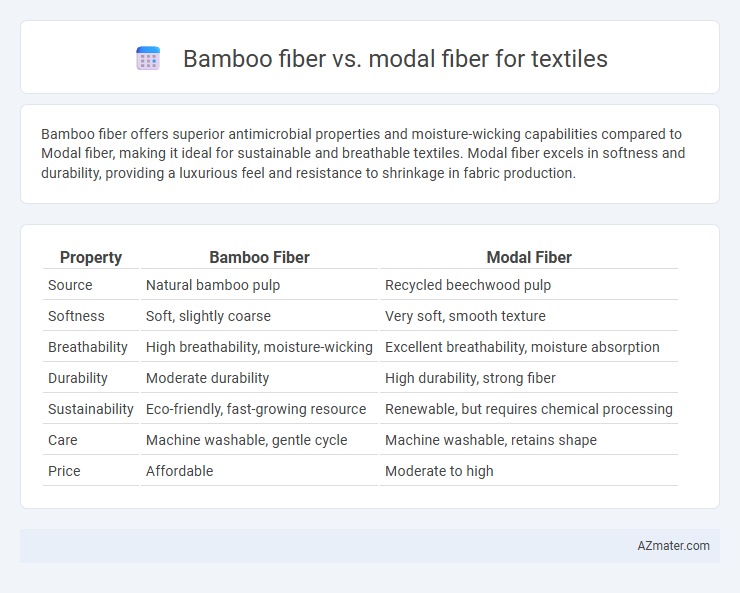Bamboo fiber offers superior antimicrobial properties and moisture-wicking capabilities compared to Modal fiber, making it ideal for sustainable and breathable textiles. Modal fiber excels in softness and durability, providing a luxurious feel and resistance to shrinkage in fabric production.
Table of Comparison
| Property | Bamboo Fiber | Modal Fiber |
|---|---|---|
| Source | Natural bamboo pulp | Recycled beechwood pulp |
| Softness | Soft, slightly coarse | Very soft, smooth texture |
| Breathability | High breathability, moisture-wicking | Excellent breathability, moisture absorption |
| Durability | Moderate durability | High durability, strong fiber |
| Sustainability | Eco-friendly, fast-growing resource | Renewable, but requires chemical processing |
| Care | Machine washable, gentle cycle | Machine washable, retains shape |
| Price | Affordable | Moderate to high |
Introduction to Bamboo Fiber and Modal Fiber
Bamboo fiber, derived from the cellulose of bamboo plants, is highly valued in textiles for its natural antibacterial properties, moisture-wicking abilities, and eco-friendly production process. Modal fiber, a type of semi-synthetic rayon made from beech tree pulp, stands out for its smooth texture, high durability, and excellent breathability in fabric applications. Both fibers are popular in sustainable fashion due to their biodegradability and comfort, yet bamboo fiber offers superior antimicrobial benefits while modal excels in softness and fabric strength.
Origins and Production Processes
Bamboo fiber originates from the cellulose extracted from bamboo plants, produced through mechanical crushing and chemical treatments to separate fibers, typically involving eco-friendly enzymatic processing for viscose bamboo. Modal fiber is derived from beech tree pulp, transformed into fibers via a chemically intensive but closed-loop process, ensuring minimal environmental impact by recycling chemicals like sodium hydroxide. Both fibers offer sustainable alternatives in textiles, with bamboo emphasizing natural regeneration and modal focusing on efficient tree harvesting and advanced fiber regeneration techniques.
Environmental Impact and Sustainability
Bamboo fiber offers significant environmental benefits due to its rapid growth rate, requiring minimal pesticides and water compared to conventional crops, making it a sustainable choice for textile production. Modal fiber, derived from beech trees, uses less water and energy in manufacturing than traditional cotton, but its impact depends largely on responsible forestry and chemical processing practices. Both fibers contribute to reducing the textile industry's carbon footprint, with bamboo excelling in renewable resource efficiency and modal providing enhanced biodegradability when sourced sustainably.
Fiber Structure and Chemical Composition
Bamboo fiber features a natural, hollow microstructure with a cellulose-rich composition primarily consisting of b-1,4-glucan chains, contributing to its breathability and moisture-wicking properties. Modal fiber, derived from beech tree cellulose, possesses a highly crystalline, smooth, and uniform fiber structure with a high degree of polymerization and purity, offering enhanced tensile strength and dye retention. The chemical composition of modal includes mainly pure cellulose with minimal lignin or hemicellulose, whereas bamboo fiber retains small amounts of lignin and hemicellulose depending on the processing method.
Softness, Comfort, and Skin-Friendliness
Bamboo fiber offers exceptional softness due to its naturally smooth texture, making it highly comfortable and gentle on sensitive skin. Modal fiber, derived from beech trees, provides a silky feel with superior moisture-wicking properties that enhance comfort in various climates. Both fibers are breathable and hypoallergenic, but bamboo fiber excels in antibacterial qualities, promoting healthier skin.
Moisture Absorption and Breathability
Bamboo fiber exhibits superior moisture absorption and breathability compared to modal fiber, making it ideal for textiles requiring high sweat-wicking capabilities. Bamboo's natural micro-gaps and micro-holes enhance air circulation and moisture evaporation, resulting in a cooler and drier fabric experience. Modal fiber, although soft and moisture-wicking, has a denser structure that retains more moisture, reducing overall breathability in performance textiles.
Durability and Strength Comparison
Bamboo fiber exhibits excellent tensile strength and natural antibacterial properties, enhancing fabric longevity and resistance to wear. Modal fiber, derived from beech wood, offers superior softness and flexibility while maintaining high durability through its semi-synthetic cellulose structure. In textile applications, bamboo fiber tends to have slightly higher durability under repeated washing, whereas modal fiber excels in maintaining strength and shape retention over extended use.
Dyeing Properties and Color Retention
Bamboo fiber exhibits excellent dye absorption and fastness due to its natural cellulose structure, resulting in vibrant colors and strong color retention after multiple washes. Modal fiber, a type of high wet modulus rayon, offers superior dyeing uniformity and enhanced color intensity, especially with reactive dyes, ensuring consistent hues and minimal fading over time. Both fibers respond well to eco-friendly dyeing processes, but modal's molecular structure provides better overall durability and colorfastness in textile applications.
Cost and Market Availability
Bamboo fiber offers a cost-effective alternative in textile production with moderate market availability due to growing consumer demand for sustainable fabrics. Modal fiber, derived from beech trees, tends to be pricier but enjoys widespread market presence because of its softness and durability. Both fibers serve eco-friendly niches, yet modal's established supply chains make it more accessible for large-scale manufacturing compared to bamboo fiber.
Conclusion: Choosing the Right Fiber for Textiles
Bamboo fiber offers exceptional sustainability with natural antibacterial properties and excellent moisture wicking, making it ideal for eco-conscious, breathable textiles. Modal fiber excels in softness, durability, and color retention, providing a luxurious feel suited for high-quality apparel and home textiles. Selecting between bamboo and modal fibers ultimately depends on prioritizing eco-friendliness versus fabric performance and tactile comfort in textile applications.

Infographic: Bamboo fiber vs Modal fiber for Textile
 azmater.com
azmater.com